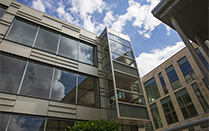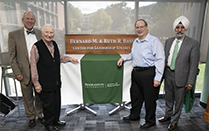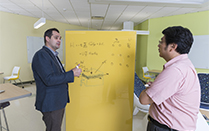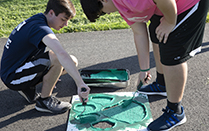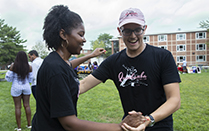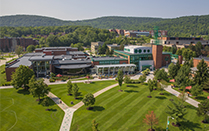Two Watson School faculty promoted to distinguished ranks
Jessica Fridrich was promoted to distinguished professor and Mark Fowler was promoted to distinguished teaching professor at the May 6 meeting of the SUNY Board of Trustees. Both members of the Department of Electrical and Computer Engineering, they join more than 75 Binghamton University faculty who have achieved distinguished rank.
Promotion to distinguished professor is reserved for those who have achieved national or international prominence and a distinguished reputation within his or her discipline. Promotion to the distinguished teaching rank recognizes the mastery of teaching at the graduate, undergraduate or professional levels.
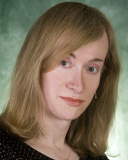
Fridrich is considered the world’s leading expert in steganography, the art and science of message hiding, and in steganalysis, the detection of those hidden messages. Called a superstar by her peers, she has written more than 160 refereed publications which have been cited more than 12,000 times, and also authored the seminal graduate textbook in steganography – Steganography in Digital Media: Principles, Algorithms, and Application – published in 2009.
Through her inventions, she has impacted society at large, wrote President Harvey Stenger in his recommendation of her for promotion: “One of the reasons that Professor Fridrich has been so impactful is the creativity of her approaches. Her ability to break codes is legendary … and her research is among the most cited in her field.”
She earned her diploma in applied mathematics from the School of Nuclear Science and Physical Engineering at Czech Technical University in 1987, and her PhD in systems Science from Binghamton University in 1995. She joined the Watson School of Engineering and Applied Science as a research scientist that year, converted to a tenure-track position 10 years later and was promoted to full professor in 2007.
The rank means a great deal to Fridrich, who knew only one distinguished professor – George Klir – when she first came to Binghamton. “He became a career model for me, a hard-working, brilliant mind, active well past the usual retirement age,” she said.
A milestone in her career came in 2004, while working with her graduate student Jan Lukas and postdoctoral assistant Miroslav Goljan on a forensic method for digital cameras, using defective pixels on a sensor. “One humid afternoon Jan came to my office and showed me a couple of graphs he generated the night before and I could hardly catch my breath,” she said. “It was instantly clear to me that we just discovered something big, very big. We stumbled across a golden nugget, but not the defective pixels. This was the serendipitous discovery of what is widely recognized today as “sensor fingerprints” and it triggered an avalanche of papers, entire sessions at conferences, two U.S. patents, a successful technology transfer story, numerous best paper awards and a lot of fun for everyone on my team. The field of digital image forensics got a major boost and I feel privileged that I could be right there and be able to contribute.”
She has garnered nearly $10 million in research grants during her time at Binghamton, from agencies including the Air Force Office of Scientific Research, the U.S. Air Force Research Laboratory and the National Science Foundation.
Fridrich holds seven patents, all which have been successfully commercialized, including one for the method of “finger printing” photographs so that they can be reliably linked to a particular camera. It is the only method approved for use as evidence in forensics cases in a court of law.
A member of the Association for Computing Machinery and the Signal Processing Society of the Institute of Electrical and Electronics Engineers (IEEE), Fridrich is also a reviewer for more than a dozen journals in her field and was associate editor and co-founder of the IEEE Transactions on Information Forensic and Security.
Fridrich thrives on the feeling of discovering something new and of being somewhere where no one has ever before ventured. “I hope to experience many more of these moments, and, in the process, help our students grow, enjoy being on the forefront of research and be able to share the excitement of research with the next generation.”
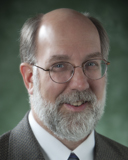
Fowler earned his associate’s degree in electrical technology from SUNY Broome Community College and his bachelor’s degree in electrical engineering technology from Binghamton University. He went on to earn his doctorate in electrical engineering from Penn State University in 1991, and worked for Lockheed Martin for eight years before joining the Watson School’s Department of Electrical and Computer Engineering in 1999. He was promoted to professor in 2008, and has earned the Chancellor’s Award for Excellence in both teaching (2007) and service (2012).
Citing Fowler’s “plunge into online education” as an example of his willingness to stretch as a teacher, Donald Nieman, executive vice president for academic affairs and provost, wrote in his recommendation for promotion that “Professor Fowler welcomes new challenges and is eager to experiment with new approaches to teaching. … [His] innovative approaches to teaching have one thing in common: they illustrate a faculty member who is focused on helping students learn challenging material and willing to try new approaches to succeed.”
“When I came to Binghamton in 1999, my goal for teaching was to find a way to move students toward true understanding,” he said. “To do that, I looked back at a couple of the very best professors I had (here at Binghamton) and tried to identify what it was that made them great teachers.
“I realized that they were relaxed and friendly in the classroom, had high standards for students, were truly invested in helping their students succeed and used unorthodox ways to describe abstract concepts. So, personally, this promotion makes me proud to have successfully carried on in the tradition of Binghamton University providing the best possible classroom experience to its students.”
One who often employs innovative teaching methods, Fowler is one of the first adopters of the “flipped” classroom in which the instructor records lectures for students to view prior to class, making class time available for hands-on learning. He also brought i>clickers into the classroom, allowing him to easily and regularly assess his students’ understanding of the course material.
Teaching at both the undergraduate and graduate level, Fowler has also served as director of his department’s graduate programs since 2008 – receiving the Provost’s Award for Outstanding Graduate Director in 2013 – and authored his department’s self-study for graduate program review.
A mentor to both students and faculty, Fowler is a regular contributor to the Center for Learning and Teaching, and colleagues note his “sincere dedication to serve students in a consistently generous manner.”
Former students remain in contact with Fowler, sending e-mails and letters telling him about their post-Binghamton University achievements – and thanking him for helping them along that path. “When I think of that I realize that my individual efforts toward effective teaching get multiplied a thousand-fold as my students go out into the world to be great engineers.”
His involvement in initiatives to improve pedagogy are deep and include development of course materials, restructuring curricula, publishing on innovative teaching methods and serving on the advisory committee for the Center for Learning and Teaching. He has also served on the Road Map Team for Advancing Learning and the Development Committee for the SUNY On-Line BEE Degree, and had guided other schools in developing electrical engineering programs and procedures to assess them.
Fowler understands that the concept of a flipped classroom is still fairly new for schools and publishers. “I’m hoping to find ways to take what I’ve been creating for use at Binghamton and move it into a more widely available framework. My work is already out there on the open Web and I get requests from professors all over the world to use it, so I’d like to explore a more formal pathway to enable others to flip their engineering classrooms.”
